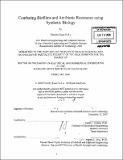Combating biofilms and antibiotic resistance using synthetic biology
Author(s)
Lu, Timothy K. (Timothy Kuan-Ta), 1981-
DownloadFull printable version (19.19Mb)
Other Contributors
Harvard University--MIT Division of Health Sciences and Technology.
Advisor
James J. Collins.
Terms of use
Metadata
Show full item recordAbstract
Bacterial infections represent a significant source of morbidity and mortality. Biofilms and antibiotic resistance pose challenges to our future ability to treat bacterial diseases with antibiotics (1). Bacteria frequently live in biofilms, which are surface-associated communities encased in a hydrated extracellular polymeric substances (EPS) matrix (2, 3). Biofilms are crucial in the pathogenesis of many clinically-important infections and are difficult to eradicate because they exhibit resistance to antimicrobial agents and removal by host immune systems (4). Antibiotics can even induce biofilm formation (5, 6). The development of antibiotic-resistant bacteria is also a growing medical problem. Antibiotic resistance genes can be acquired by horizontal gene transfer and passed vertically to later generations (7). Antibiotic resistance can also result from persistence, a phenomena in which a subpopulation of cells can withstand antibiotic treatment without containing antibiotic-resistance genes (8). These problems, coupled with decreasing output of new antibiotics, have highlighted the need for new treatments for bacterial infections (1, 9-12). I developed three novel strategies for attacking bacterial biofilms and antibiotic resistance using synthetic biology. To remove biofilms, I engineered bacteriophage to express a biofilm degrading enzyme during infection to simultaneously attack biofilm cells and the biofilm EPS matrix. These enzymatically-active bacteriophage substantially reduced biofilm cell counts by 4.5 orders of magnitude (-99.997% removal), which was about two orders of magnitude better than that of non-enzymatic phage. To address antibiotic-resistant bacteria, I targeted gene networks with synthetic bacteriophage to create antibiotic adjuvants. (cont.) Suppressing the SOS network with engineered bacteriophage enhanced killing by ofloxacin, a quinolone drug, by over 2.7 and 4.5 orders of magnitude compared with control bacteriophage plus ofloxacin and ofloxacin alone, respectively. I also built phage that targeted multiple gene networks and demonstrated their effectiveness as antibiotic adjuvants. Engineered bacteriophage reduced the number of antibiotic-resistant bacteria and performed as strong adjuvants for other bactericidal antibiotics such as aminoglycosides and P-lactams. Finally, I designed synthetic in vivo sensors for antibiotic-resistance genes that can be coupled with effector components to kill cells carrying resistance genes or to block horizontal transmission of those genes. My work demonstrates the feasibility and benefits of using engineered bacteriophage and synthetic biology constructs to address the dual threats of bacterial biofilms and antibiotic-resistant bacteria.
Description
Thesis (Ph. D.)--Harvard-MIT Division of Health Sciences and Technology, 2008. Includes bibliographical references (leaves 81-86).
Date issued
2008Department
Harvard University--MIT Division of Health Sciences and TechnologyPublisher
Massachusetts Institute of Technology
Keywords
Harvard University--MIT Division of Health Sciences and Technology.